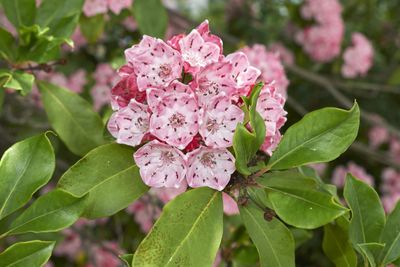Mountain laurel is a North American native evergreen shrub. It produces lovely spring flowers that look a bit like brightly colored candy. It is hardy in United States Department of Agriculture zones 4 to 9. This rather broad distribution makes the plant well adapted to many conditions. However, they do not perform well in clay soil, and need dappled light in southern locations. A mountain laurel losing leaves may be suffering from too much sun if they are in hot, scorching light.
Fungal Leaf Drop on Mountain Laurels
Fungal diseases primarily occur when temperatures are warm and conditions are wet or humid. Fungal spores bloom on consistently wet leaves causing spotting, lesions, halos and eventually die-off of the leaf. When a mountain laurel is losing its leaves, look for any of these disfigurements. The fungal agent may be Phyllosticta, Diaporthe or many others. The key is to clean up dropped leaves and use a fungicide early in spring and a couple of other times during the growing season. Never water over the plant or when leaves will not have time to dry before night fall.
Environmental Conditions and No Leaves on Mountain Laurel
Plants in clay soil may have trouble taking up nutrients which can cause leaf drop. A more common cause is iron chlorosis, which can be recognized by yellow mottling of the leaves. This is due to a lack of iron coming into the plant, likely because the pH is above 6.0 and interferes with the plant’s ability to harvest iron. A soil test can tell if the soil itself is low in iron or if the pH needs to be changed. To lower the pH, add compost, peat moss or sulfur to the soil. A quick fix is to give the plant a foliar spray of iron. Extreme cold is another reason for mountain laurel leaf drop. In areas that get sustained freezes, plant mountain laurels in a slightly sheltered location. Lack of water will also cause dropped leaves. Provide deep watering once per week in dry conditions.
Pests and Leaf Drop on Mountain Laurels
Insect pests are another common reason for a mountain laurel losing leaves. The two most common pests are borers and weevils. Borers tunnel into woody tissue and disrupt the vascular system, interrupting the cycle of nutrients and water. This girdling will effectively starve and dehydrate the plant. Weevils feed on the leaves, but their larvae eat the roots. This also affects the plant’s ability to bring in nourishment. The borers will respond to Bacillus thuringiensis while weevils can be caught in sticky traps placed at the base of the plant. Occasionally, lace bug infestations and their sucking activity will cause leaf drop. Control with pyrethroid insecticides.
